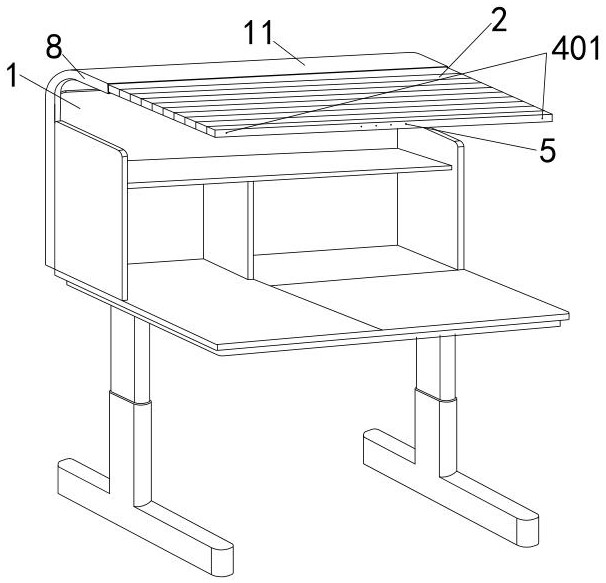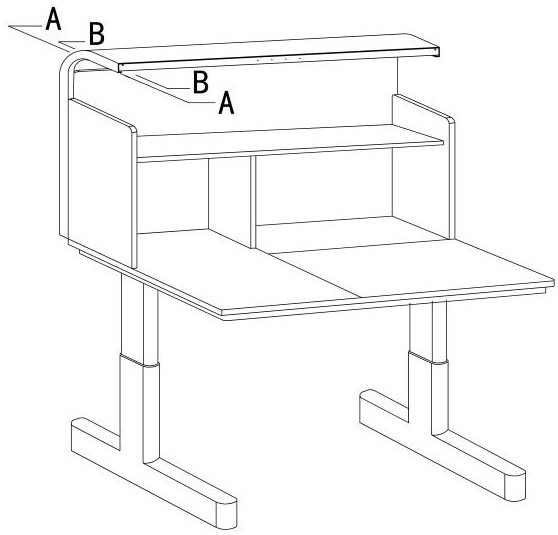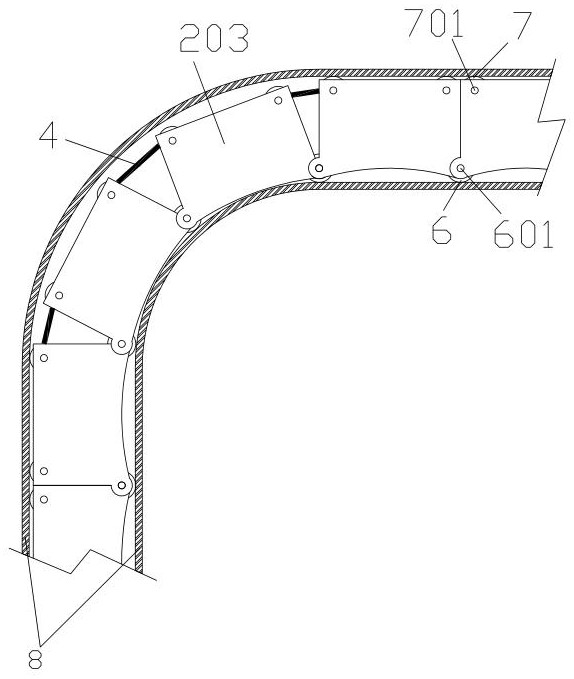[0003] One is that the brightness of the light-emitting surface exceeds the standard seriously: because the
desk lamp must consider convenience, beauty, and anti-overturning reasons, it is impossible to make the light-emitting surface of the lamp head very large, mostly within the range of tens to two to three hundred square centimeters. , the brightness of the light-emitting surface of the table lamp is mostly in the range of 10000cd-30000cd / m 2 between, far beyond the current
national standard of "no more than 2000cd / m 2 If the height of the light pole is not limited, the direct glare will be serious, and it will not pass the national inspection; in order to achieve the goal of not exceeding the brightness of the light-emitting surface, the current solution is to make the light-emitting surface diffuse the lampshade with various small concave-convex patterns , this method can only slightly improve the glare angle, but cannot fundamentally change the problem that the brightness greatly exceeds the standard; the second is to limit the height of the lamp pole. According to the
national standard on the detection method of the brightness of the light-emitting surface of the reading and writing
desk lamp, the height of the
luminance meter probe from the table is 40cm. Therefore, the height of the light pole of most desk lamps is also designed at about 40cm, and no matter how much the brightness exceeds the standard, it will not be detected. This method seems to have avoided the national inspection, but it has caused the next problem.
[0004] The second is that there is a huge difference between the upper and lower light and shade of the user's
line of sight: if the table lamp is placed on the table for use, the height of 40cm is basically the same as the height of the
human eye, and the light and dark difference between the upper and lower eyes is huge and blocks the
line of sight. Severe glare, in a dilemma! Moreover, the height of children in the lower grades is much lower than that of adults, so no glare from the perspective of adults does not mean no glare from the perspective of children; currently, some desk lamp products increase the brightness of the background by faintly emitting light from the back, and improve the problem of the difference between light and shade, but this solution is limited Due to the glare requirements of the back
light source, the improvement effect is extremely limited
[0005] The third is poor desktop
illuminance uniformity: due to the small light-emitting area of the table lamp, the height of the lamp head is relatively low from the table top, so the table lamp’s light-emitting
surface projection is the center of the table lamp and the
diffusion illuminance decreases sharply along the surroundings. Phenomenon
The
national standard stipulates that the reading and writing work table lamp is based on the projection point of the geometric center of the light-emitting surface on the desktop, and the illuminance uniformity is not greater than 3 in the 120-degree angle facing the person and the
radius of 30cm in the fan-shaped area. The illuminance uniformity is not greater than 3. Based on this calculation, even if the requirements of the national standard are met, the illuminance ratio between the two ends of the 1-meter-long desktop and the center can reach 9 times. Many existing products are more serious in practical applications; some people try to use polarized lenses. , reflectors, etc. to control the distribution of light to achieve the purpose of uniform illumination of the desktop, but this method strengthens the beaming direction of the light, resulting in a further increase in contrast with the surrounding light and shade
[0006] Fourth, the reflected glare on the paper surface is obvious: because the light-emitting surface of the desk lamp is very bright, and it is generally located at a certain distance in front of the person when in use, the light source and the desktop reading / operation area are at a certain
oblique angle rather than perpendicular to it. It is easy to form a reflection
angle condition between the eyes and the eyes in a wide range. The strong light directly reflects into the eyes and causes reflection glare. It is also difficult to see the contents of the paper in the reflection area, especially the
reflectivity of glossy white paper and
coated paper. Higher paper is more serious. Although it can be avoided by changing the position of the lamp and adjusting the reading angle of the book, it is difficult to ensure that users, especially children, can be self-disciplined every time because the lamp is easy to move and the writing and reading methods are diverse. Guaranteed to be in a scientifically sound position, so it is difficult to avoid reflection glare
[0007] Fifth, there are shadows: Since the desk lamp is a
point light source compared to the desktop, the light diverges in one direction around, and the backlight surface will form obvious shadows in the process of writing, painting, operation, etc., especially when the book is in an upright state and the
drawing board Can hardly provide normal lighting when standing at a large angle
[0010] At present, large-area planar lamps are widely used in indoor scenes such as offices, businesses, and schools. They are installed at relatively high altitudes on the top of the illuminated surface, and the glare is controlled by avoiding the glare angle of the
line of sight and increasing the shading angle of the grille. Nor does it reduce the brightness to reach the qualified glare value range. If this method is used for home desk lighting, it will destroy the decoration style and require additional construction in the later stage, which is generally unacceptable.
[0011] Therefore, from the perspective of the existing technology, in the field of desktop lighting such as reading and writing operations and precision operations, no matter whether it is a local high-altitude lighting method using a top lamp or a short-distance lighting method in which a table lamp is not higher than the eyes, each is facing its own difficulties. The problems to be overcome, even if some solutions solve one aspect but create new problems, or some solutions seem to solve some problems, but the promotion is limited due to the complexity of the
system or the implementation method is difficult for users to accept, and is not commercially viable. practicality
 Login to View More
Login to View More 


